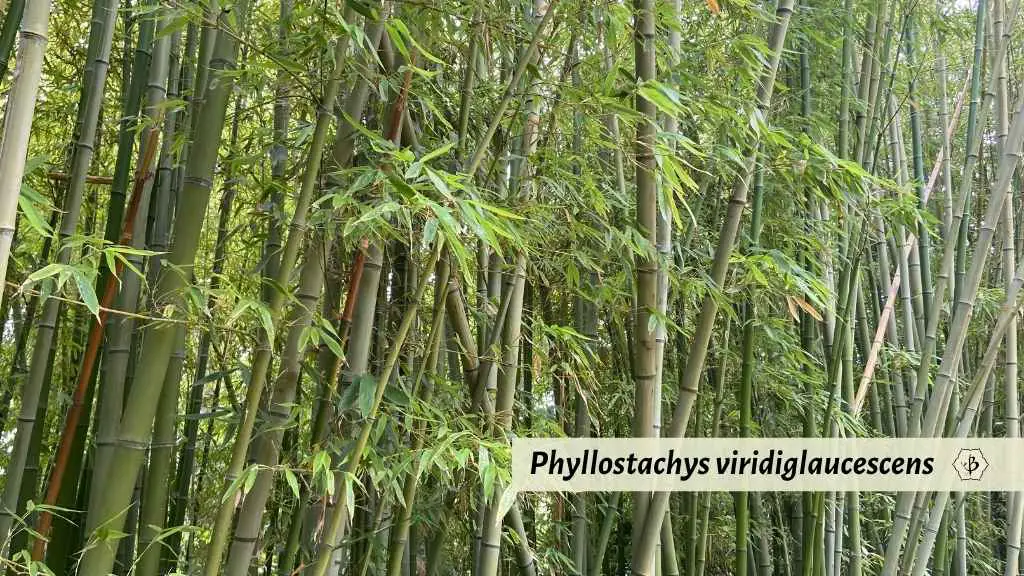For those of us who don’t live in a bamboo haven like Thailand, Brazil, or somewhere else near the equator, the genus Phyllostachys is the group of bamboo we are most familiar with. This category of cold-hardy, running bamboo includes species like Moso, perhaps the most economically important bamboo variety on earth. It also includes a host of smaller, ornamental bamboos. And then there is Phyllostachys viridiglaucescens.
Phyllostachys viridiglaucescens is a medium to large bamboo, native to China, with a running growth habit and partial to temperate climates. Also called Green Wax Bamboo or Green Glaucous Bamboo, the species has thick foliage and beautiful, upright culms that vary from golf-course green to dusty gray, reaching 25-40 feet tall. This variety is especially attractive as an ornamental but also has high-quality, nearly solid poles, ideal for light construction. Prominent nodal joints add visual interest.
This article — first published in November 2022 and last updated in April 2024 — is part of an ongoing series about different species and cultivars of bamboo. To learn more, check out some of these other detailed articles.
- BAMBOO SPECIES GUIDE
- A gallery of bamboo species
- Black Bamboo: Phyllostachys nigra and others
- Buddha’s Belly Bamboo
- Chimonobambusa quadrangularis: Square Bamboo
- Golden Bamboo: Phyllostachys aurea and others
- Hiroshima Bamboo
- Pseudosasa amabilis: Tonkin Bamboo
- Purple Bamboo: An online phenomenon

Characteristics of Phyllostachys viridiglaucescens
GROWTH HABIT
Like all members of this genus, Phyllostachys viridiglaucescens is a monopodial bamboo with a running growth habit. That means it will spread out. Therefore you should use some form of containment before you plant it in your yard. But it’s not hyper-aggressive like some other bamboo varieties. If you manage the growth and thin out the old culms on a regular basis, it will tend to stay within reasonable limits.
SIZE AND APPEARANCE
Not quite timber bamboo, Phyllostachys viridiglaucescens towers over 20 feet tall, closer to 40 under ideal circumstances. Culms are very straight and upright, up to 2 or 3 inches in diameter, and are nearly solid rather than hollow. The poles generally grow pretty close together, forming a dense thicket. The foliage is also fairly thick, making for an effective privacy screen.
This species is probably most distinguishable for its lush green color. Not only are the leaves bright green, but the poles are also vibrant and verdant. Over time, the radiant green fades to a more grayish color, but still very attractive. The bottom halves of the culms usually have far fewer leaves and branches, leaving the elegant poles clearly visible. Upon closer inspection, the nodes of the culms are visually pronounced, lending even greater character.

GROWING CONDITIONS
While the rich greenery of this bamboo species produces an air of tropical splendor, Phyllostachys viridiglaucescens is actually a temperate plant that can tolerate winter temperatures down to around 5º below zero Fahrenheit. At the same time, it’s also heat-tolerant, so it’s quite adaptable.
Phyllostachys viridiglaucescens is more commonly grown in Europe than in the US for some reason. It likes the mid-Atlantic influence and can grow well in a range of habitats. It requires full sun or minimal shade. The soil should be moist but well-drained, and a slightly acidic pH is ideal.
Withholding water and keeping the plant a bit drier is usually a good way to make the culm walls thicker or nearly solid.

Uses of Phyllostachys viridiglaucescens
Although it’s not at the top of most bamboo growers’ lists, this is a very beautiful and versatile species. As an ornamental, this tall, evergreen grass will keep the garden looking lively throughout the year. It looks good alongside other tall trees, both conifers and deciduous. And it’s equally compatible in a subtropical setting, among palm trees, oleanders and succulents.
The sturdy poles of Phyllostachys viridiglaucescens are excellent for crafts and building. Be aware, however, not all the poles will grow perfectly straight. They are not as big as Moso or Henon, but the culms are nearly solid or else have very thick walls that make them unusually strong and resistant to cracking. The species is especially valuable to furniture makers who prefer medium-sized bamboo with even consistency and reliable strength.

If you’re growing or making anything from Green Glaucous Bamboo, please send us a photo, we’d love to hear from you.
Learn more
I hope you found this article on Phyllostachys viridiglaucescens interesting and enjoyable. Perhaps you will decide to plant some in your yard and maybe use the poles to build a treehouse! To learn more about the wonders bamboo, check out some of these popular articles.
- Myths and legends about bamboo
- Bamboo and oxygen
- Growing bamboo for carbon credits
- Bamboo and biochar
FEATURE IMAGE: Phyllostachys viridiglaucescens grove in northeast Spain near the Mediterranean. Photo by Fred Hornaday.

























